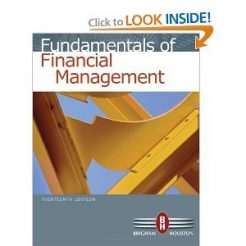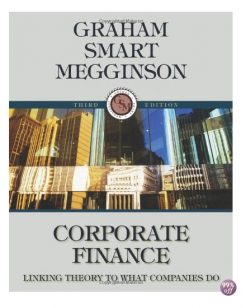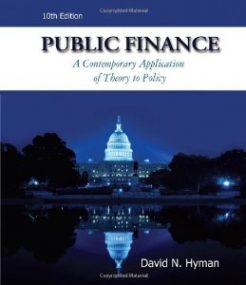Description
Fundamentals of Investments Valuation and Management Jordan 7th Edition Solutions Manual
Fundamentals of Investments Valuation and Management Jordan 7th Edition Solutions Manual
***THIS IS NOT THE ACTUAL BOOK. YOU ARE BUYING the Solution Manual in e-version of the following book***
Name: Fundamentals of Investments Valuation and Management
Author: Jordan
Edition: 7th
ISBN-10: 0077861639
Type: Solutions Manual
– The file contains solutions and questions to all chapters and all questions. All the files are carefully checked and accuracy is ensured.
– The file is either in .doc, .padf, excel, or zipped in the package and can easily be read on PCs and Macs.
– Delivery is INSTANT. You can download the files IMMEDIATELY once payment is done.
If you have any questions, please feel free to contact us. Our response is the fastest. All questions will always be answered in 6 hours., most of the time within 30mins
We also faced similar difficulities when we were students, and we understand how you feel.
But now, with the Fundamentals of Investments Valuation and Management Solution Manual, you will be able to
* Have your homework problems solved readily.
* Reduces the hassle and stress of your student life.
* Improve your studying and also get a better grade!
* Get prepared for examination questions.
*Can save you time and help you understand the material.
This is the quality of service we are providing and we hope to be your helper.
Delivery is in the next moment. Solution Manual is accurate.
Prepare to receive your Fundamentals of Investments Valuation and Management Solution Manual in the next moment.
If you have any questions, or would like a receive a sample chapter before your purchase, please contact us at inquiry@testbankcorp.com
Fundamentals of Investments Valuation and Management Solution Manual
Fundamentals of Investments Valuation and Management Jordan 7th Edition Solutions Manual ISBN: 0077861639
Chapter 1
A Brief History of Risk and Return
Concept Questions
1. For both risk and return, increasing order is b, c, a, d. On average, the higher the risk of an investment, the higher is its expected return.
2. Since the price didn’t change, the capital gains yield was zero. If the total return was four percent, then the dividend yield must be four percent.
3. It is impossible to lose more than –100 percent of your investment. Therefore, return distributions are cut off on the lower tail at –100 percent; if returns were truly normally distributed, you could lose much more.
4. To calculate an arithmetic return, you simply sum the returns and divide by the number of returns. As such, arithmetic returns do not account for the effects of compounding. Geometric returns do account for the effects of compounding and for changes in the base used for each year’s calculation of returns. As an investor, the more important return of an asset is the geometric return.
5. Blume’s formula uses the arithmetic and geometric returns along with the number of observations to approximate a holding period return. When predicting a holding period return, the arithmetic return will tend to be too high and the geometric return will tend to be too low. Blume’s formula adjusts these returns for different holding period expected returns.
6. T-bill rates were highest in the early eighties since inflation at the time was relatively high. As we discuss in our chapter on interest rates, rates on T-bills will almost always be slightly higher than the expected rate of inflation.
7. Risk premiums are about the same whether or not we account for inflation. The reason is that risk premiums are the difference between two returns, so inflation essentially nets out.
8. Returns, risk premiums, and volatility would all be lower than we estimated because aftertax returns are smaller than pretax returns.
9. We have seen that T-bills barely kept up with inflation before taxes. After taxes, investors in T-bills actually lost ground (assuming anything other than a very low tax rate). Thus, an all T-bill strategy will probably lose money in real dollars for a taxable investor.
10. It is important not to lose sight of the fact that the results we have discussed cover over 80 years, well beyond the investing lifetime for most of us. There have been extended periods during which small stocks have done terribly. Thus, one reason most investors will choose not to pursue a 100 percent stock (particularly small-cap stocks) strategy is that many investors have relatively short horizons, and high volatility investments may be very inappropriate in such cases. There are other reasons, but we will defer discussion of these to later chapters.
Solutions to Questions and Problems
NOTE: All end of chapter problems were solved using a spreadsheet. Many problems require multiple steps. Due to space and readability constraints, when these intermediate steps are included in this solutions manual, rounding may appear to have occurred. However, the final answer for each problem is found without rounding during any step in the problem.
Core Questions
1. Total dollar return = 100($41 – 37 + 0.28) = $428.00
Whether you choose to sell the stock or not does not affect the gain or loss for the year; your stock is worth what it would bring if you sold it. Whether you choose to do so or not is irrelevant (ignoring commissions and taxes).
2. Capital gains yield = ($41 – 37) / $37 = 10.81%
Dividend yield = $0.28 / $37 = 0.76%
Total rate of return = 10.81% + 0.76% = 11.57%
3. Dollar return = 500($34 – 37 + 0.28) = –$1,360
Capital gains yield = ($34 – 37) / $37 = –8.11%
Dividend yield = $0.28 / $37 = 0.76%
Total rate of return = –8.11% + 0.76% = –7.35%
4. a. average return = 6.2%, average risk premium = 2.5%
b. average return = 3.7%, average risk premium = 0%
c. average return = 11.7%, average risk premium = 8.0%
d. average return = 17.5%, average risk premium = 13.8%
5. Cherry average return = (17% + 11% – 2% + 3% + 14%) / 5 = 8.60%
Straw average return = (16% + 18% – 6% + 1% + 22%) / 5 = 10.20%
6. Cherry: RA = 8.60%
Var = 1/4[(.17 – .086)2 + (.11 – .086)2 + (–.02 – .086)2 + (.03 – .086)2 + (.14 – .086)2] = .00623
Standard deviation = (0.00623)1/2 = .0789, or 7.89%
Straw: RB = 10.20%
Var = 1/4[(.16 – .102)2 + (.18 – .102)2 + (–.06 – .102)2 + (.01 – .102)2 + (.22 – .102)2] = .01452
Standard deviation = (0.01452)1/2 = .1205, or 12.05%
7. The capital gains yield is ($59 – 65)/$65 = –.0923, or –9.23% (notice the negative sign). With a dividend yield of 1.2 percent, the total return is –8.03%.
8. Geometric return = [(1 + .17)(1 + .11)(1 – .02)(1 + .03)(1 + .14)](1/5) – 1 = .0837, or 8.37%
9. Arithmetic return = (.21 + .12 + .07 –.13 – .04 + .26) / 6 = .0817, or 8.17%
Geometric return = [(1 + .21)(1 + .12)(1 + .07)(1 – .13)(1 – .04)(1 + .26)](1/6) – 1 = .0730, or 7.30%
Intermediate Questions
10. That’s plus or minus one standard deviation, so about two-thirds of the time, or two years out of three. In one year out of three, you will be outside this range, implying that you will be below it one year out of six and above it one year out of six.
11. You lose money if you have a negative return. With a 12 percent expected return and a 6 percent standard deviation, a zero return is two standard deviations below the average. The odds of being outside (above or below) two standard deviations are 5 percent; the odds of being below are half that, or 2.5 percent. (It’s actually 2.28 percent.) You should expect to lose money only 2.5 years out of every 100. It’s a pretty safe investment.
12. The average return is 6.2 percent, with a standard deviation of 12.2 percent, so Prob( Return < –6.0 or Return > 18.4 ) ? 1/3, but we are only interested in one tail; Prob( Return < –6.0) ? 1/6, which is half of 1/3 . 95%: 6.2 ± 2? = 6.2 ± 2(12.2) = –18.2% to 30.6% 99%: 6.2 ± 3? = 6.2 ± 3(12.2) = –30.4% to 42.8% 13. Expected return = 17.5% ; ? = 36.6%. Doubling your money is a 100% return, so if the return distribution is normal, Z = (100 – 17.5)/36.6 = 2.25 standard deviations; this is in-between two and three standard deviations, so the probability is small, somewhere between .5% and 2.5% (why?). Referring to the nearest Z table, the actual probability is = 1.209%, or about once every 100 years. Tripling your money would be Z = (200 – 17.5)/ 36.6 = 4.986 standard deviations; this corresponds to a probability of (much) less than 0.5%, or once every 200 years. (The actual answer is less than once every 1 million years, so don’t hold your breath.) 14. Year Common stocks T-bill return Risk premium 1973 –14.69% 7.29% –21.98% 1974 –26.47% 7.99% –34.46% 1975 37.23% 5.87% 31.36% 1796 23.93% 5.07% 18.86% 1977 –7.16% 5.45% –12.61% sum 12.84% 31.67% –18.83% a. Annual risk premium = Common stock return – T-bill return (see table above). b. Average returns: Common stocks = 12.84 / 5 = 2.57% ; T-bills = 31.67 / 5 = 6.33%; Risk premium = –18.83 / 5 = –3.77% c. Common stocks: Var = 1/4[ (–.1469 – .0257)2 + (–.2647 – .0257)2 + (.3723 – .0257)2 + (.2393 – .0257)2 + (–.0716 – .0257)2] = .072337 Standard deviation = (0.072337)1/2 = .2690 = 26.90% T-bills: Var = 1/4[(.0729 – .0633)2 + (.0799 – .0633)2 + (.0587 – .0633)2 + (.0507–.0633)2 + (.0545 – .0633)2] = .0001565 Standard deviation = (.000156)1/2 = .0125 = 1.25% Risk premium: Var = 1/4[(–.2198 – (–.0377))2 + (–.3446 – (–.0377))2 + (.3136 – (–.0377))2 + (.1886 – (–.0377))2 + (–.1261 – (–.0377))2] = .077446 Standard deviation = (.077446)1/2 = .2783 = 27.83% d. Before the fact, the risk premium will be positive; investors demand compensation over and above the risk-free return to invest their money in the risky asset. After the fact, the observed risk premium can be negative if the asset’s nominal return is unexpectedly low, the risk-free return is unexpectedly high, or any combination of these two events. 15. ($324,000 / $1,000)1/50 – 1 = .1226, or 12.26% 16. 5 year estimate = [(5 – 1)/(40 – 1)] × 10.24% + [(40 – 5)/(40 – 1)] × 12.60% = 12.36% 10 year estimate = [(10 – 1)/(40 – 1)] × 10.24% + [(40 – 10)/(40 – 1)] × 12.60% = 12.06% 20 year estimate = [(20 – 1)/(40 – 1)] × 10.24% + [(40 – 20)/(40 – 1)] × 12.60% = 11.45% 17. Small company stocks = ($21,997.36/ $1)1/87 – 1 = .1218, or 12.18% Large company stocks = ($3,247.50 / $1)1/87 – 1 = .0974, or 9.74% Long-term government bonds = ($112.14 / $1)1/87 – 1 = .0557, or 5.57% Treasury bills = ($22.39 / $1)1/87 – 1 = .0364, or 3.64% Inflation = ($12.83 / $1)1/87 – 1 = .0298, or 2.98% 18. RA = (–.09 + .17 + .09 + .14 – .04) / 5 = .0540, or 5.40% RG = [(1 – .09)(1 + .17)(1 + .09)(1 + .14)(1 – .04)]1/5 – 1 = .0490, or 4.90% 19. R1 = ($15.61 – 13.25 + 0.15) / $13.25 = 18.94% R2 = ($16.72 – 15.61 + 0.18) / $15.61 = 8.26% R3 = ($15.18 – 16.72 + 0.20) / $16.72 = –8.01% R4 = ($17.12 – 15.18 + 0.24) / $15.18 = 14.36% R5 = ($20.43 – 17.12 + 0.28) / $17.12 = 20.97% RA = (.1894 + .0826 – .0801 + .1436 + .2097) / 5 = .1090, or 10.90% RG = [(1 + .1894)(1 + .0826)(1 – .0801)(1 + .1436)(1 + .2097)]1/5 – 1 = .1038, or 10.38% 20. Stock A: RA = (.08 + .08 + .08 + .08 + .08) / 5 = .0800, or 8.00% Var = 1/4[(.08 – .08)2 + (.08 – .08)2 + (.08 – .08)2 + (.08 – .08)2 + (.08 – .08)2] = .000000 Standard deviation = (.000)1/2 = .000, or 0.00% RG = [(1 + .08)(1 + .08)(1 + .08)(1 +.08)(1 + .08)]1/5 – 1 = .0800, or 8.00% Stock B: RA = (.03 + .13 + .07 + .05 + .12) / 5 = .0800, or 8.00% Var = 1/4[(.03 – .08)2 + (.13 – .08)2 + (.07 – .08)2 + (.05 – .08)2 + (.12 – .08)2] = .001900 Standard deviation = (.001900)1/2 = .0436, or 4.36% RG = [(1 + .03)(1 + .13)(1 + .07)(1 + .05)(1 + .12)]1/5 – 1 = .0793, or 7.93% Stock C: RA = (–.24 + .37 + .14 + .09 + .04) / 5 = .0800. or 8.00% Var = 1/4[(–.24 – .08)2 + (.37 – .08)2 + (.14 – .08)2 + (.09 – .08)2 + (.04 – .08)2] = .047950 Standard deviation = (.047950)1/2 = .2190, or 21.90% RG = [(1 – .24)(1 + .37)(1 + .14)(1 + .09)(1 + .04)]1/5 – 1 = .0612, or 6.12% The larger the standard deviation, the greater will be the difference between the arithmetic return and geometric return. In fact, for lognormally distributed returns, another formula to find the geometric return is: arithmetic return – ½ variance. Therefore, for Stock C, we get .0800 – ½(.047950) = .0560. The difference in this case is because the return sample is not a true lognormal distribution.







Reviews
There are no reviews yet.